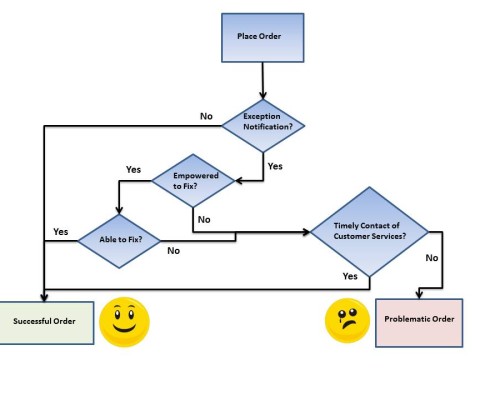Share
Author
Sam Bayer
Share
How to eliminate SAP order errors
Fail and Fix SAP® Orders Faster.
Ill-formed SAP® orders exist. Always have. Always will. Whether they come in via EDI, Fax, email or even eCommerce Websites like ours, they will never be 100% well-formed. People, and computers, make mistakes. (I recently wrote about the extent of ill-formed EDI orders here.)
What’s the secret to winning the battle against ill-formed orders?
Our view at Corevist is to reject the ill-formed orders as quickly as possible (preferably in real time while the customer is available) and provide the customer the information and tools required for them to fix their own orders as fast as possible.
It’s that simple and it’s that hard.
Consider the following flow chart that inspects the route taken from the moment an order is assembled and Placed by a Customer to it’s receipt by the Supplier’s SAP® system:
The shortest path, from a customer assembling and Placing an Order to posting to the Supplier’s SAP® system, is if No Exception Notifications are issued (see the “No” path from Exception Notification to Successful Order). In our case at Corevist, that’s the posting of an Order into SAP® in real time and the customer getting an SAP® Order Number in their confirmation notification.
That’s all done in real time and, depending on the number of line items in the order, should take less than three seconds to accomplish.
But the moment an Exception is tripped up the clock starts to tick. And to be sure, exceptions, to varying degrees, will always be there. (In my next post, I’ll dig a little deeper into data that we’ve been able to mine from our existing website users. It sheds light on the iterative “fail/fix” journey that even website users go through while placing their real time orders into SAP®.)
Exceptions can be classified as either errors or warnings. Errors will prevent the processing of the orders while Warnings might simply inform the customer of potential deviations from their expectations. There can be Exceptions at the order header like:
- missing or invalid PO number provided,
- unrecognized ShipTo location,
- credit limits exceeded etc.
Or there can be errors/warnings with the line items themselves like:
- obsolete part number
- unrecognized part number
- minimum order quantities exist
- parts will be substituted
- invalid price provided etc.
But let’s get back to that ticking clock.
Exception Notification? – How long does it take for a customer to be notified that the order they sent you can’t be processed as received?
Seconds? Minutes? Hours or days?
In a dramatic illustration of “unintended consequences“, do your Customer Service Representatives (CSR) intervene and fix those orders without notifying the customer that they’ve had a problem with their order? If so, your CSRs may think they’re doing your customers a favor but all they are really doing is ensuring that all future orders will contain those very same errors (wrong part numbers, minimum quantities, etc.) and will suffer similar manual intervention delays.
Empowered to Fix? – Assuming you have notified your customer of the errors in their orders in a timely fashion, have they also been given enough information to fix the error on their own? For instance, if there are minimum order quantities, what are they? If they haven’t been provided with this level of information, and they have to get in touch with your CSRs, how long does it take to get in touch with them? What if your customers are on different continents with major time zone differences and phone calls aren’t an option? How much time will transpire before errors are understood and fixed?
Seconds? Minutes? Hours or days?
Able to Fix? – Lastly, even if your customer has been notified of a problem with their order in a timely fashion and has been given the information they need to correct their order, how easy is it for them to fix the problem? Will they have to go back to their own IT department to implement a permanent fix? Will they have to get in touch with your CSRs in order to communicate their choices? How long will that take?
Seconds? Minutes? Hours or days?
Summary
Yes, receiving orders from your customers could happen at the speed of light. You may even be able to instantly translate the EDI transaction, the XML definitions or perform an accurate Optical Character Recognition transformation of the fax. However, a large percentage of your orders will contain Exceptions. For those that don’t, life is good. But for those orders that are ill-formed and fail to process automatically, the key to success is to Fail and Fix them as Fast as you can!
I’m hoping to extend the capabilities of our Corevist service to provide this sort of “Fail and Fix Fast” capability for EDI and Fax orders in the near future.
Watch this space for developments :-).
Sam









